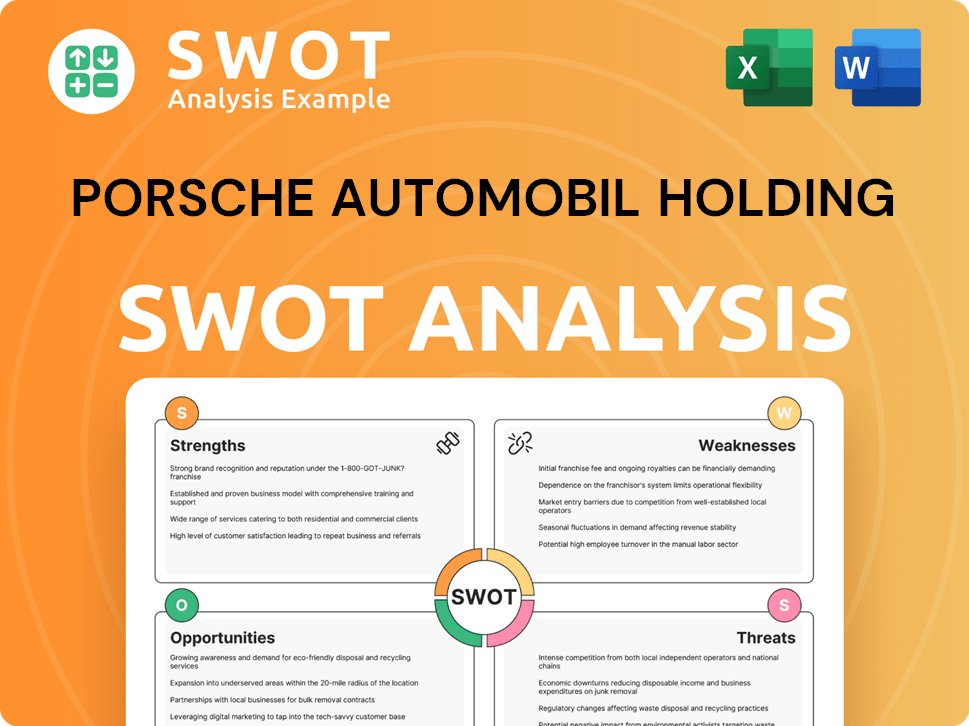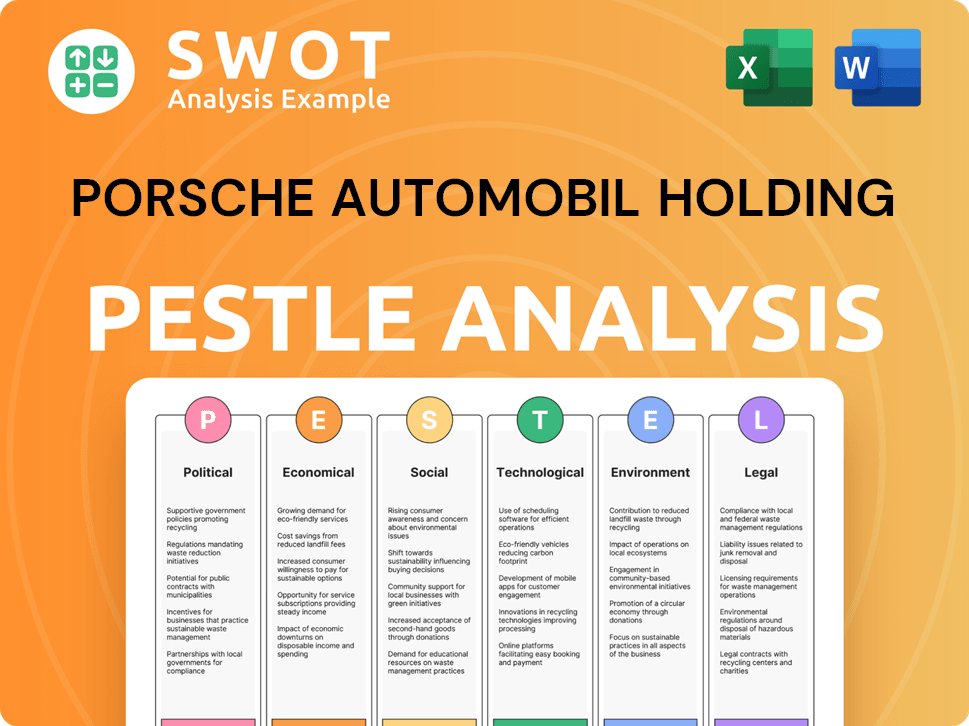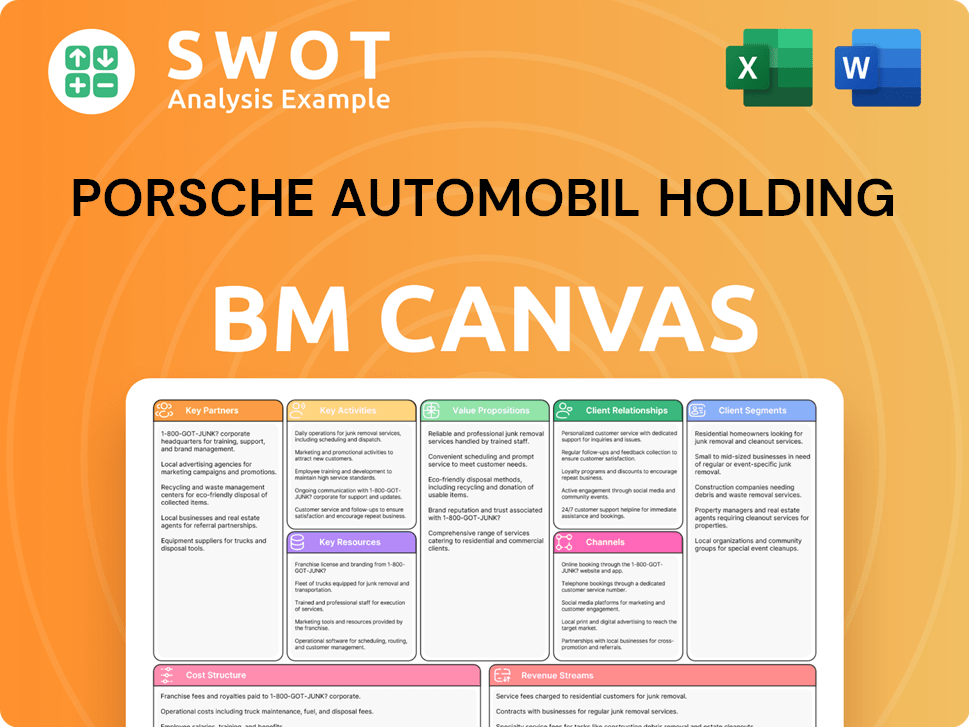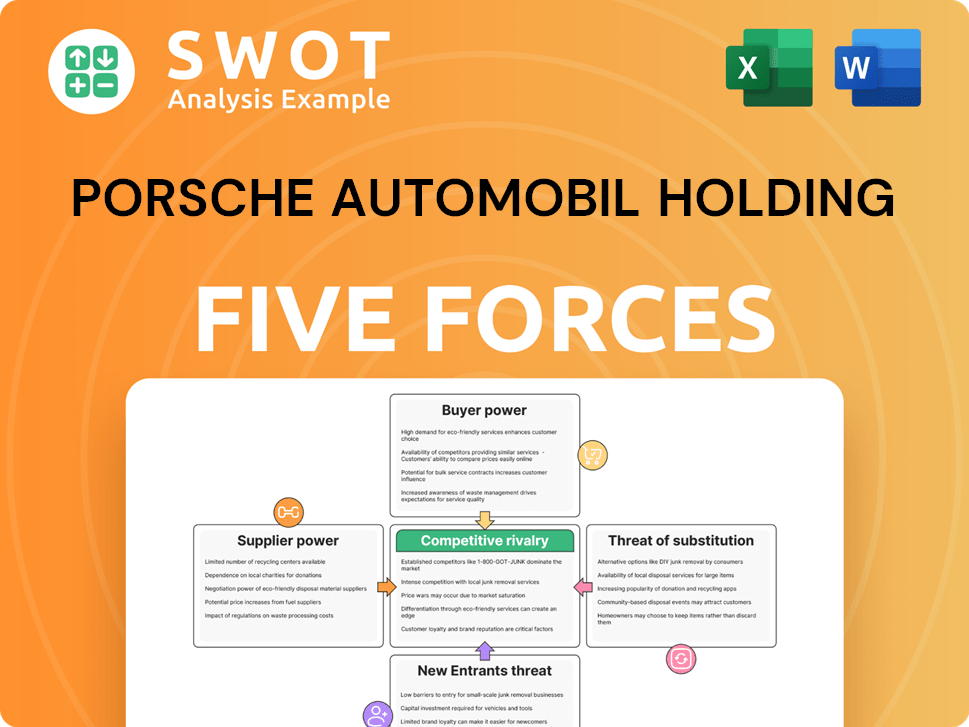Porsche Automobil Holding Bundle
Who are the Customers Driving Porsche Automobil Holding Company's Success?
In the dynamic automotive landscape, understanding customer demographics and target markets is key. Porsche Automobil Holding Company, with its significant stake in Volkswagen AG, navigates this complexity. This analysis delves into the diverse customer base influencing Porsche SE's strategic decisions and investment performance, from luxury car buyers to mass-market consumers.

This exploration goes beyond direct 'Porsche' branded vehicles, focusing on the broader Volkswagen Group's customer ecosystem. Understanding the Porsche Automobil Holding SWOT Analysis and the interplay between ICE and EV markets, along with the impacts of digitalization and sustainability, is crucial. We'll examine the Porsche customer profile, including demographics, income levels, and buyer motivations, to provide a comprehensive Porsche market analysis. This insight will help assess how Porsche SE adapts to evolving consumer preferences and maintain its market share worldwide.
Who Are Porsche Automobil Holding’s Main Customers?
The primary customer segments for Porsche Automobil Holding SE are indirectly defined by the brands within Volkswagen AG, in which Porsche SE holds a significant investment. This includes a wide spectrum from ultra-luxury to mass-market vehicles. Understanding the Porsche customer profile and the broader Porsche target market is crucial for analyzing the company's performance.
The luxury and premium segments, which include brands like Porsche, Audi, Bentley, and Lamborghini, primarily target affluent individuals. These customers are typically male, aged 35-65+, with high disposable incomes and executive or professional occupations. They prioritize performance, brand prestige, and advanced technology. The mass-market brands, such as Volkswagen, Skoda, and SEAT, cater to a broader demographic, emphasizing practicality and value.
The shift towards electric vehicles (EVs) is reshaping target segments across all brands, attracting environmentally conscious buyers and those seeking innovative technology. Volkswagen's ID. series, for example, aims to broaden the consumer base for EVs. The company serves both consumers (B2C) and businesses (B2B) through fleet sales and commercial vehicles, with B2C representing the largest share of revenue. The Porsche Automobil Holding Company is experiencing growth in the EV segment, driven by increasing consumer awareness and governmental incentives.
This segment focuses on high-net-worth individuals. Key demographics include males aged 35-65+, with executive or professional occupations. These customers value performance, brand prestige, and customization. The average income of a Porsche owner in the US is often over $300,000 annually. Brief History of Porsche Automobil Holding provides further context.
This segment targets a broader demographic, prioritizing practicality and value. Consumers in this segment range across various ages and income levels. They are often focused on fuel efficiency, safety, and reliability. Brands like Volkswagen cater to this segment with models designed for everyday use.
The EV segment is experiencing rapid growth across all brands. It attracts environmentally conscious buyers and those seeking advanced technology. Volkswagen's ID. series is a key player in this segment, aiming to broaden the consumer base. Governmental incentives and increasing consumer awareness are driving this growth.
The company serves both consumers (B2C) and businesses (B2B). B2C sales represent the largest share of revenue. Fleet sales and commercial vehicles contribute to the B2B segment. The strategic balance between these segments supports overall revenue generation and market penetration.
Understanding Porsche buyers and their motivations is crucial for strategic planning. Porsche customer income levels and location are key factors. Analyzing Porsche market analysis data helps identify emerging trends.
- Porsche customer location: Primarily in North America, Europe, and China.
- Porsche car price range demographics: Varies widely depending on the model, from around $60,000 to over $200,000.
- Porsche customer preferences: High performance, luxury, and advanced technology.
- Porsche brand loyalty demographics: Strong brand loyalty among existing owners.
Porsche Automobil Holding SWOT Analysis
- Complete SWOT Breakdown
- Fully Customizable
- Editable in Excel & Word
- Professional Formatting
- Investor-Ready Format

What Do Porsche Automobil Holding’s Customers Want?
Understanding the needs and preferences of customers is crucial for the success of Porsche Automobil Holding Company. The desires of customers for luxury brands like Porsche are primarily driven by psychological and aspirational factors. These include a desire for status, exclusivity, and a unique driving experience. The company's ability to meet these needs directly influences its market position.
Porsche customers are often influenced by brand heritage, design aesthetics, and the ability to personalize their vehicles. Porsche offers extensive customization options to cater to these desires, reflecting a deep understanding of their target market. The decision-making process for these customers involves emotional connection, brand loyalty, and the perceived value of their investment.
For the broader Volkswagen Group, which indirectly influences Porsche SE, customer needs vary across different segments. While luxury segments prioritize emotional connections, mass-market segments focus on practical considerations such as reliability, safety, and fuel efficiency. The increasing demand for sustainable mobility also plays a significant role, with a growing preference for electric and hybrid vehicles across all segments. This is reflected in the Growth Strategy of Porsche Automobil Holding.
Porsche's customer base is diverse, but several key preferences drive their purchasing decisions. These preferences are shaped by lifestyle, income levels, and geographical location. Understanding these preferences is essential for effective market analysis and strategic planning.
- Performance and Driving Experience: Customers seek high-performance vehicles with exceptional handling and a thrilling driving experience.
- Luxury and Exclusivity: The brand's image and the prestige associated with owning a Porsche are significant factors.
- Customization and Personalization: The ability to tailor a vehicle to their individual tastes is highly valued.
- Brand Heritage and Design: Porsche's iconic design and rich history are important to buyers.
- Technological Advancement: Integration of advanced technology, including infotainment and driver-assistance systems, is increasingly important.
Porsche Automobil Holding PESTLE Analysis
- Covers All 6 PESTLE Categories
- No Research Needed – Save Hours of Work
- Built by Experts, Trusted by Consultants
- Instant Download, Ready to Use
- 100% Editable, Fully Customizable

Where does Porsche Automobil Holding operate?
The geographical market presence of Porsche Automobil Holding SE, through its indirect ownership of Volkswagen AG, is extensive, spanning across numerous countries and continents. This global reach is a key factor in its overall market success. The company's strategic approach involves tailoring products and marketing efforts to suit the specific needs and preferences of customers in different regions.
Europe, North America, and the Asia-Pacific region are the most significant markets for the Volkswagen Group, which includes Porsche. These regions are crucial for sales and revenue generation. The company's ability to adapt to diverse customer demographics and market conditions is essential for maintaining a strong global presence and achieving sustainable growth.
In 2023, the Volkswagen Group delivered approximately 3.27 million vehicles in Western Europe, highlighting the region's importance. The Asia-Pacific area, particularly China, is another vital market, with 3.2 million vehicles delivered in the same year. North America, especially the United States, is also a key market, with a growing emphasis on SUVs and electric vehicles. These numbers demonstrate the global footprint and the strategic importance of each region.
Europe remains a core market for the Volkswagen Group, with Germany, the UK, and France being particularly significant. The company benefits from strong brand recognition and market leadership across various vehicle segments in this region. Localized marketing strategies and product offerings are crucial to cater to the diverse customer preferences within Europe.
The Asia-Pacific region, especially China, is a critical growth market for the Volkswagen Group. China is the largest single market for the company. Volkswagen has adapted its offerings in China by developing specific models and features to meet the preferences of Chinese consumers, such as extended-wheelbase versions.
North America, particularly the United States, is a key region with a focus on SUVs and electric vehicles. The Volkswagen Group is aiming to increase its EV sales in the US, with plans for local production and new models. The company is strategically expanding its production footprint to support regional demand and supply chain resilience.
Differences in customer demographics, preferences, and buying power across these regions necessitate localized marketing strategies and product portfolios. For instance, while luxury sedans might be popular in certain Asian markets, pickup trucks and large SUVs dominate in North America. This approach is essential for maximizing sales and market share.
The success of Porsche Automobil Holding Company and its indirect investments in the automotive sector is closely tied to its ability to understand and adapt to the unique demands of each geographical market. This includes not only product offerings but also the overall Porsche customer profile.
- Europe: Strong brand recognition and market leadership.
- Asia-Pacific: Rapid growth, especially in China, with localized models.
- North America: Focus on SUVs and EVs, with plans for local production.
- Localized Strategies: Tailored marketing and product portfolios to meet regional needs.
Porsche Automobil Holding Business Model Canvas
- Complete 9-Block Business Model Canvas
- Effortlessly Communicate Your Business Strategy
- Investor-Ready BMC Format
- 100% Editable and Customizable
- Clear and Structured Layout

How Does Porsche Automobil Holding Win & Keep Customers?
The customer acquisition and retention strategies of Porsche Automobil Holding SE are largely managed through the Volkswagen Group's extensive network, employing a comprehensive multi-channel approach. This strategy focuses on digital marketing, traditional advertising, and personalized customer experiences to attract and retain customers. The company leverages data analytics and CRM systems to understand and cater to its diverse customer base, ensuring tailored marketing messages and offers.
Digital marketing is a cornerstone of these strategies, with significant investments in social media campaigns, search engine optimization (SEO), and targeted online advertising. Traditional advertising methods, including television commercials and print media, remain important for brand building and promoting new model launches. Sales tactics often include competitive financing options, leasing programs, and attractive trade-in offers to incentivize purchases.
Loyalty programs are also key, featuring exclusive events for existing owners and service benefits to cultivate long-term relationships. After-sales service, including maintenance packages and warranty programs, is crucial for customer retention. The shift towards electric vehicles (EVs) has led to new acquisition strategies focused on educating consumers about EV benefits and charging infrastructure. A detailed understanding of Owners & Shareholders of Porsche Automobil Holding can provide additional insights into the company's strategic direction.
Digital marketing is a core component, with social media campaigns, SEO, and targeted online ads. The company utilizes data analytics and CRM systems to segment customers and deliver personalized marketing messages. In 2024, digital ad spending in the automotive sector reached approximately $18 billion in the United States alone.
Traditional advertising, including TV commercials and print media, is used for brand building and new model launches. This approach helps to maintain brand visibility and reach a broad audience. In 2023, the global advertising market for luxury cars was estimated at around $40 billion.
Competitive financing options, leasing programs, and trade-in offers are used to attract customers. These incentives aim to make Porsche vehicles more accessible. The automotive finance market is projected to reach $1.7 trillion by 2025.
Loyalty programs provide exclusive events and service benefits to foster long-term relationships. These programs enhance customer satisfaction and encourage repeat purchases. Customer retention can increase profits by 25% to 95%, according to research.
Focus on educating consumers about EV benefits, charging infrastructure, and total cost of ownership. This includes showcasing the advantages of electric vehicles and addressing concerns about range and charging. The global EV market is expected to grow significantly, with sales projected to reach 26.8 million units by 2030.
- Highlighting the environmental benefits of EVs.
- Providing information on available charging stations.
- Offering transparent pricing and total cost comparisons.
- Showcasing the performance and technological advancements of EV models.
Porsche Automobil Holding Porter's Five Forces Analysis
- Covers All 5 Competitive Forces in Detail
- Structured for Consultants, Students, and Founders
- 100% Editable in Microsoft Word & Excel
- Instant Digital Download – Use Immediately
- Compatible with Mac & PC – Fully Unlocked

Related Blogs
- What are Mission Vision & Core Values of Porsche Automobil Holding Company?
- What is Competitive Landscape of Porsche Automobil Holding Company?
- What is Growth Strategy and Future Prospects of Porsche Automobil Holding Company?
- How Does Porsche Automobil Holding Company Work?
- What is Sales and Marketing Strategy of Porsche Automobil Holding Company?
- What is Brief History of Porsche Automobil Holding Company?
- Who Owns Porsche Automobil Holding Company?
Disclaimer
All information, articles, and product details provided on this website are for general informational and educational purposes only. We do not claim any ownership over, nor do we intend to infringe upon, any trademarks, copyrights, logos, brand names, or other intellectual property mentioned or depicted on this site. Such intellectual property remains the property of its respective owners, and any references here are made solely for identification or informational purposes, without implying any affiliation, endorsement, or partnership.
We make no representations or warranties, express or implied, regarding the accuracy, completeness, or suitability of any content or products presented. Nothing on this website should be construed as legal, tax, investment, financial, medical, or other professional advice. In addition, no part of this site—including articles or product references—constitutes a solicitation, recommendation, endorsement, advertisement, or offer to buy or sell any securities, franchises, or other financial instruments, particularly in jurisdictions where such activity would be unlawful.
All content is of a general nature and may not address the specific circumstances of any individual or entity. It is not a substitute for professional advice or services. Any actions you take based on the information provided here are strictly at your own risk. You accept full responsibility for any decisions or outcomes arising from your use of this website and agree to release us from any liability in connection with your use of, or reliance upon, the content or products found herein.